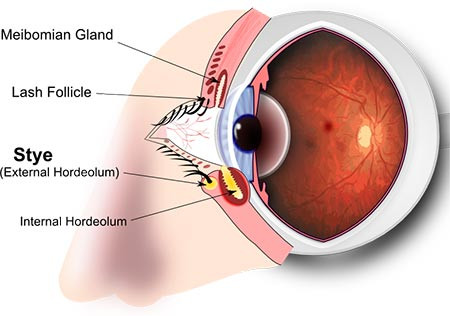An eye stye, also known medically as a hordeolum, is that bothersome, pimple-like bump that can appear on your eyelid. It’s often red, swollen, and can be quite tender. While many styes resolve on their own, sometimes they need a doctor’s attention. Knowing when to seek help from a doctor for a stye is crucial for prompt treatment and preventing potential complications.
 Eye Stye Treatment · NYC Eye Doctor
Eye Stye Treatment · NYC Eye Doctor
Recognizing Stye Symptoms: When is it More Than Just a Bump?
Identifying a stye is usually straightforward. The most common sign is a visible lump on the eyelid that resembles a pimple. You might notice it on the edge of your eyelid, either upper or lower. If you’ve had styes before, you’ll likely recognize the familiar discomfort and appearance.
Besides the characteristic bump, other symptoms associated with a stye can include:
- Swelling in a localized area of the eye or the entire eyelid
- Eye pain or tenderness when touched
- Redness around the bump and surrounding eyelid
- Increased sensitivity to light
- Excessive tearing or watery eyes
- A sensation of something being stuck in your eye
- Puffiness around the eye area
- A gritty or dry feeling in the eye
While many styes will start to improve within a couple of days, it’s important to monitor your symptoms. If your stye persists or worsens after 48 hours, consulting an eye doctor is advisable to rule out other issues and receive appropriate guidance. Furthermore, if you experience spreading redness, swelling extending to your cheek or other parts of your face, seek immediate medical attention from an eye care professional. These could be signs of a more serious condition requiring prompt intervention from a doctor for your stye.
What Causes a Stye and Who is at Risk?
The primary culprit behind most styes is the bacterium Staphylococcus aureus. This bacteria is commonly found in the nose, and styes often develop when it’s transferred to the eye, usually by rubbing or touching the nose and then the eyes.
Styes are considered contagious because the bacteria can spread. However, many people carry staph bacteria without developing a stye. Nevertheless, practicing good hygiene is important, especially when you have a stye, to prevent spreading it to others:
- Wash your hands frequently, particularly before touching your eyes.
- Avoid sharing personal items like towels, washcloths, pillowcases, and eye makeup.
- Ensure washcloths are cleaned after each use.
Certain factors can increase your risk of developing a stye:
- Using old or expired eye makeup, which can harbor bacteria.
- Having rosacea, a skin condition that can affect the eyelids.
- Sleeping in eye makeup, which can clog eyelid glands.
- Blepharitis, inflammation of the eyelids, increases stye risk.
- Handling contact lenses without thoroughly washing hands first.
When to See a Doctor for Your Stye: Diagnosis and Treatment
Often, an eye doctor, whether an optometrist or ophthalmologist, can diagnose a stye simply by examining your eye. They may use magnification to get a closer look and confirm the diagnosis. It’s important to differentiate a stye from other conditions that can mimic its appearance, such as:
- Chalazion: Also caused by blocked eyelid glands, chalazia tend to be harder and develop further from the eyelid edge than styes.
- Xanthelasma: Yellowish bumps under the skin, often around the eyes, related to lipid deposits.
- Milia: Small, white cysts that can appear around the eyes and nose.
If your stye is persistent, painful, or affecting your vision, it’s time to see a Doctor For Stye treatment. Treatments prescribed by a doctor may include:
- Home remedies guidance: Doctors often recommend warm compresses applied for 5-10 minutes, several times a day, along with gentle massage to encourage drainage.
- Antibiotics: If the infection is more severe or spreading, oral antibiotic pills or tablets might be prescribed.
- Antibiotic eye drops or ointments: Topical antibiotics can be applied directly to the stye to combat the bacterial infection.
- Stye surgery (incision and drainage): In cases where a stye doesn’t respond to other treatments, a minor in-office surgical procedure to drain the pus may be necessary.
Potential Complications and Why Prompt Care Matters
It’s crucial to avoid squeezing or popping a stye yourself, as this can worsen the infection and potentially spread it. Allowing a stye to drain naturally or with a doctor’s intervention is the safest approach.
Untreated styes that don’t resolve can sometimes lead to a more serious condition called pre-septal cellulitis. This is an infection of the eyelid and surrounding tissues that requires hospital treatment with intravenous antibiotics. Seeking timely care from a doctor for a stye can help prevent such complications.
If you are experiencing any unusual eye symptoms or are concerned about a stye, it’s always best to consult with an eye care professional. An optometrist or ophthalmologist can provide an accurate diagnosis and recommend the most effective treatment plan to ensure the health of your eyes.
Disclaimer: This article provides general information and should not be considered medical advice. Always consult with a qualified eye doctor for diagnosis and treatment of any eye condition.
